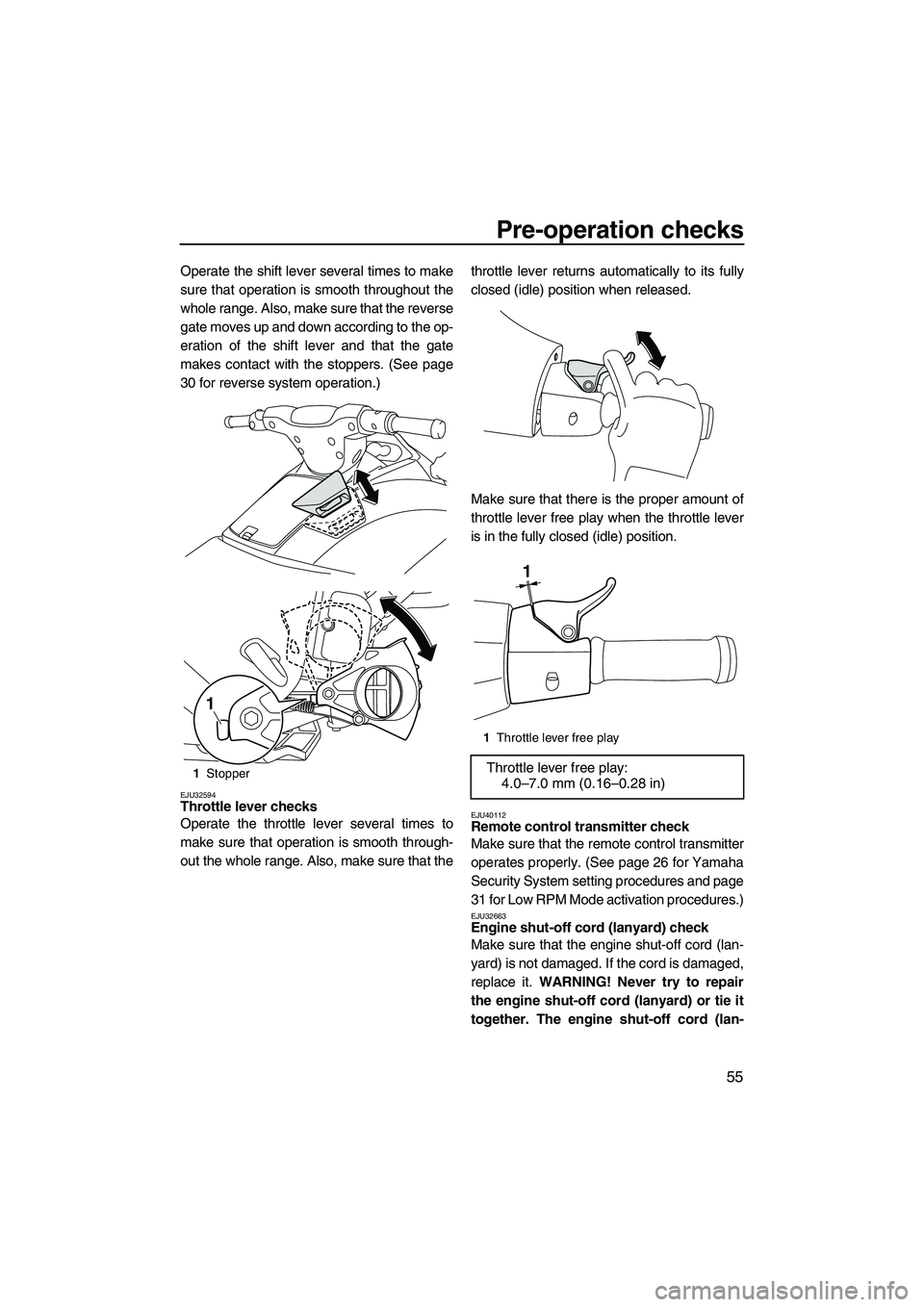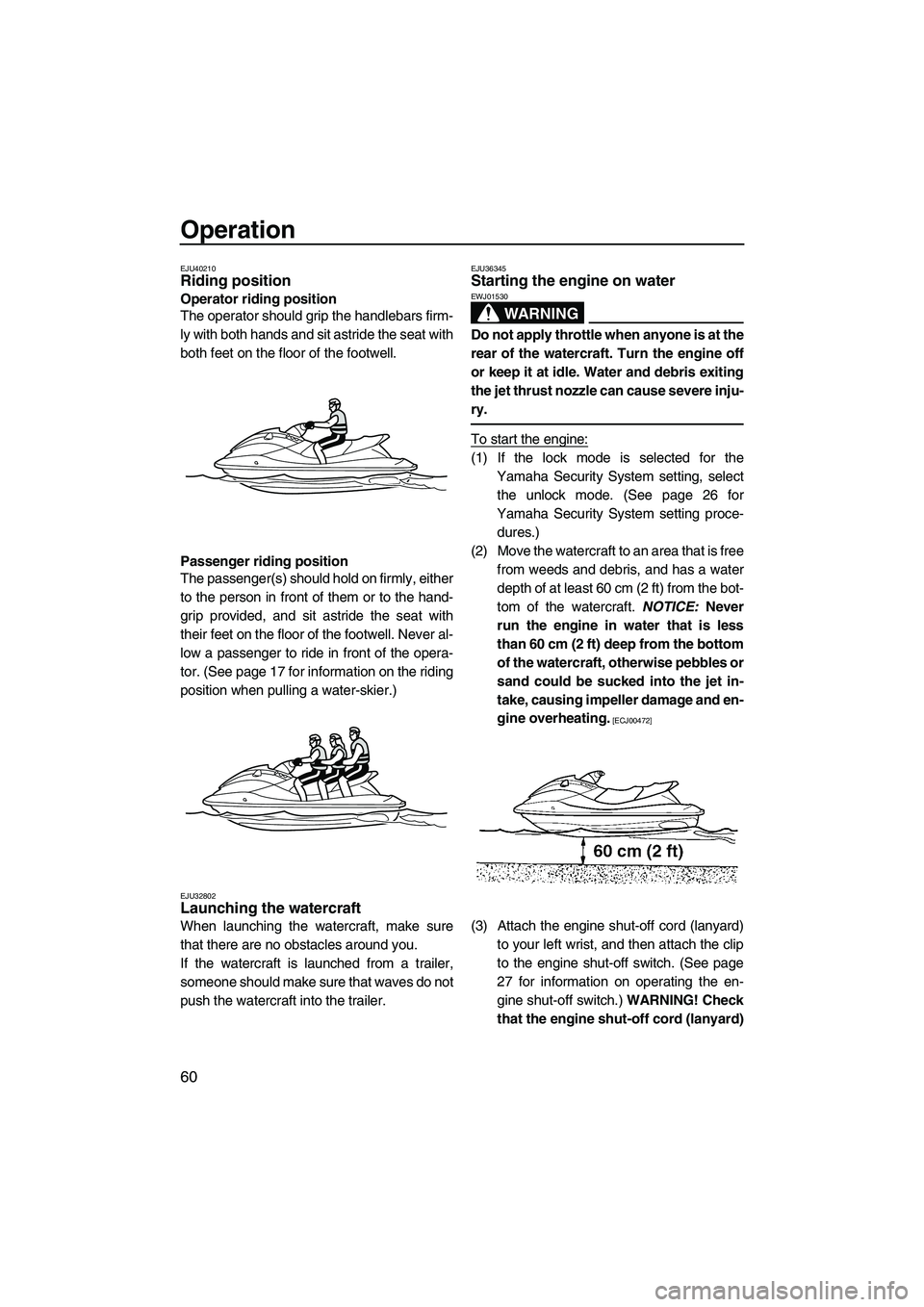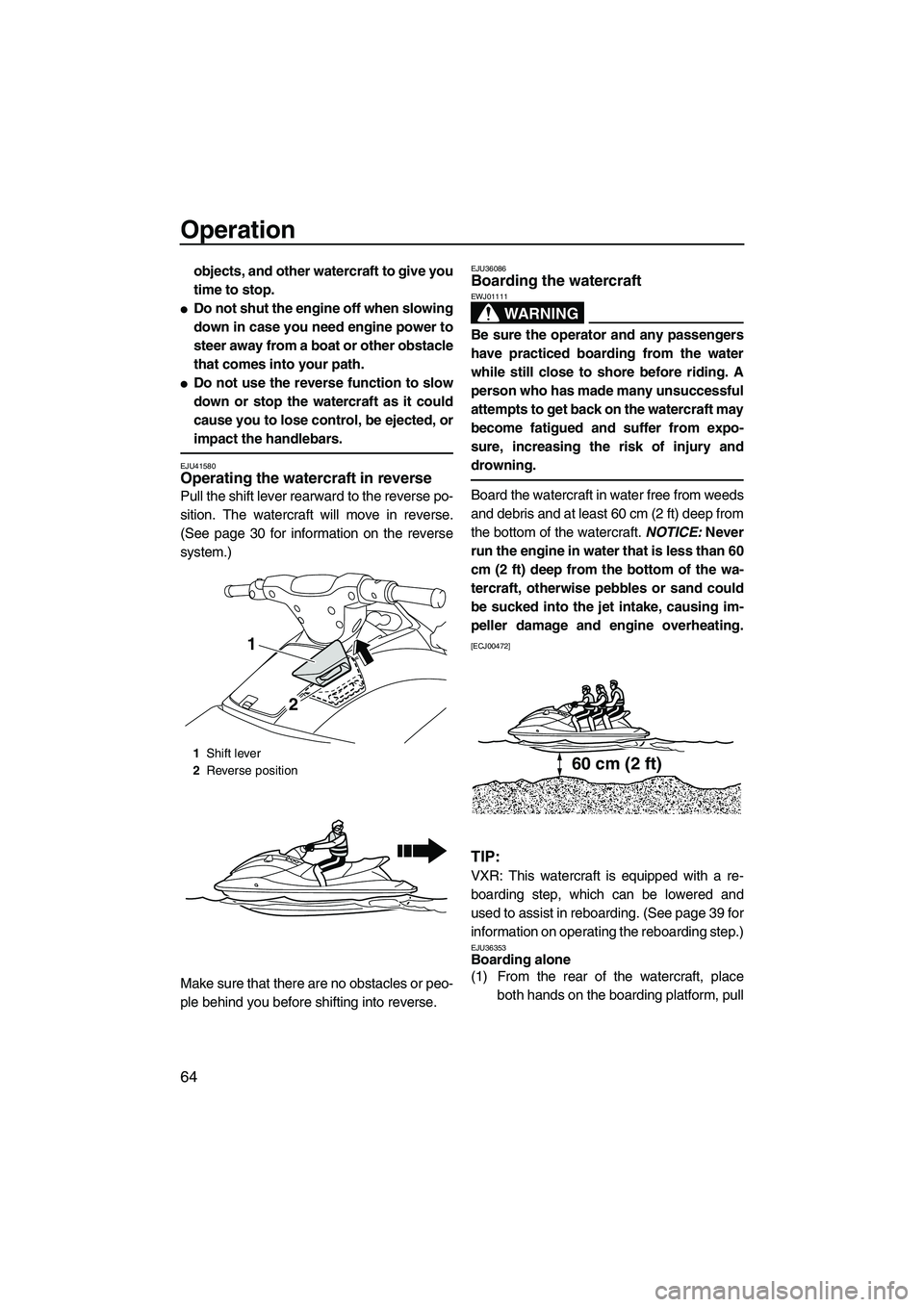YAMAHA VXR 2013 Repair Manual
Manufacturer: YAMAHA, Model Year: 2013, Model line: VXR, Model: YAMAHA VXR 2013Pages: 98, PDF Size: 3.89 MB
Page 61 of 98

Pre-operation checks
55
Operate the shift lever several times to make
sure that operation is smooth throughout the
whole range. Also, make sure that the reverse
gate moves up and down according to the op-
eration of the shift lever and that the gate
makes contact with the stoppers. (See page
30 for reverse system operation.)
EJU32594Throttle lever checks
Operate the throttle lever several times to
make sure that operation is smooth through-
out the whole range. Also, make sure that thethrottle lever returns automatically to its fully
closed (idle) position when released.
Make sure that there is the proper amount of
throttle lever free play when the throttle lever
is in the fully closed (idle) position.EJU40112Remote control transmitter check
Make sure that the remote control transmitter
operates properly. (See page 26 for Yamaha
Security System setting procedures and page
31 for Low RPM Mode activation procedures.)
EJU32663Engine shut-off cord (lanyard) check
Make sure that the engine shut-off cord (lan-
yard) is not damaged. If the cord is damaged,
replace it.
WARNING! Never try to repair
the engine shut-off cord (lanyard) or tie it
together. The engine shut-off cord (lan-
1 Stopper
1
1Throttle lever free play
Throttle lever free play:
4.0–7.0 mm (0.16–0.28 in)
1
UF2M72E0.book Page 55 Thursday, July 12, 2012 5:05 PM
Page 62 of 98
![YAMAHA VXR 2013 Repair Manual Pre-operation checks
56
yard) may not pull free when the operator
falls off, allowing the watercraft to contin-
ue to run and cause an accident.
[EWJ01220]
EJU32675
Switch checks
NOTICE
ECJ01310
Do YAMAHA VXR 2013 Repair Manual Pre-operation checks
56
yard) may not pull free when the operator
falls off, allowing the watercraft to contin-
ue to run and cause an accident.
[EWJ01220]
EJU32675
Switch checks
NOTICE
ECJ01310
Do](/img/51/52212/w960_52212-61.png)
Pre-operation checks
56
yard) may not pull free when the operator
falls off, allowing the watercraft to contin-
ue to run and cause an accident.
[EWJ01220]
EJU32675
Switch checks
NOTICE
ECJ01310
Do not run the engine over 4000 r/min on
land. Also, do not run the engine for more
than 15 seconds without supplying water,
otherwise the engine could overheat.
Check the start switch, the engine stop
switch, and the engine shut-off switch for
proper operation. (See pages 27 to 27 for in-
formation on operating each switch.) To check the operation of the switches:
(1) If the lock mode is selected for the
Yamaha Security System setting, selectthe unlock mode. (See page 26 for
Yamaha Security System setting proce- dures.)
(2) Push the start switch to make sure that the engine starts.
(3) As soon as the engine starts running, push the engine stop switch to make sure
that the engine stops immediately.
(4) Restart the engine, and then pull the en- gine shut-off cord (lanyard) to remove the
clip from the engine shut-off switch to
make sure that the engine stops immedi-
ately.
EJU40101Storage compartment checks
Make sure that the storage compartments are
not damaged and that water has not collected
in the compartments. (See page 40 for infor-
mation on the storage compartments.)
EJU41081Fire extinguisher holder, cover, and band
checks
Make sure that the fire extinguisher holder,
cover, and band are not damaged and that
the cover is securely held in place using the
band. (See page 42 for information on the fire
extinguisher holder, cover, and band.)
1Engine shut-off switch
2 Clip
3 Start switch
4 Engine stop switch
5 Engine shut-off cord (lanyard)
123
4 5
UF2M72E0.book Page 56 Thursday, July 12, 2012 5:05 PM
Page 63 of 98

Pre-operation checks
57
EJU32543Fire extinguisher check
Check that there is a full fire extinguisher on
board.
To check the fire extinguisher, see the instruc-
tions supplied by the fire extinguisher manu-
facturer. Always keep the fire extinguisher
secured in the holder with its cover in place.
Always carry a fire extinguisher on board. A
fire extinguisher is not standard equipment
with this watercraft. If you do not have one,
contact a Yamaha dealer or a fire extinguisher
dealer to obtain one meeting the proper spec-
ifications.
EJU40121Safety equipment check
Check that safety equipment meeting the ap-
plicable regulations is on board.
EJU32352Hull and deck check
Check the hull and deck for damage or other
problem.
EJU32656Jet intake checks
Make sure that the jet intake is not damaged
or clogged with weeds or debris. If the jet in-
take is clogged, clean it. (See page 85 for in-
formation on the jet intake.)
EJU32475Stern drain plug checks
Loosen the stern drain plugs and remove
them, and then make sure that the plugs are
not damaged and that there is no foreign ma-
terial on the threads. NOTICE: Before in- stalling the stern drain plugs, clean the
drain plug threads to remove any foreign
materials, such as dirt or sand. Otherwise,
the stern drain plugs could be damaged,
allowing water to enter the engine com-
partment. Make sure that the stern drain
plugs are tightened securely before
launching the watercraft. Otherwise, water
may flood the engine compartment and
cause the watercraft to submerge.
[ECJ00361]
Securely install the stern drain plugs by tight-
ening them until they stop.
1
Stern drain plug
1
UF2M72E0.book Page 57 Thursday, July 12, 2012 5:05 PM
Page 64 of 98

Pre-operation checks
58
EJU41440Hood check
Push down on the rear of the hood and make
sure that it is securely closed.
EJU40144Post-launch checks
Perform the post-launch checks in the pre-op-
eration checklist while the watercraft is in the
water and the engine is running.
To perform the post-launch checks:
(1) Launch the watercraft. (See page 60 forinformation on launching the watercraft.)
(2) Perform the checks and make sure that there are no malfunctioning items or oth-
er problems.
EJU40552Cooling water pilot outlet check
Make sure that water is discharged from the
cooling water pilot outlet while the engine is
running. (See page 29 for information on the
cooling water pilot outlet.)
EJU32714Multifunction information center check
Make sure that the multifunction information
center operates properly. (See page 33 for in-
formation on proper operation of the multi-
function information center.)
EJU40171Engine idling speed check
Start the engine and warm it up. Use the ta-
chometer in the multifunction information cen-
ter to make sure that the engine idling speed
is not significantly above or below the speci-
fied range.
Engine idling speed:1300 ±100 r/min
UF2M72E0.book Page 58 Thursday, July 12, 2012 5:05 PM
Page 65 of 98

Operation
59
EJU32902
Operating your watercraft
WARNING
EWJ00510
Before operating your watercraft, become
familiar with all of the controls. Consult a
Yamaha dealer about any control or func- tion that you do not fully understand. Fail-
ure to understand how the controls work
could cause an accident or prevent you
from avoiding an accident.
EJU32963Getting to know your watercraft
Operating your watercraft requires skills ac-
quired through practice over a period of time.
Take the time to learn the basic techniques
well before attempting more difficult maneu-
vers.
Operating your new watercraft can be a very
enjoyable activity, providing you with hours of
pleasure. However, it is essential to familiar-
ize yourself with the operation of the water-
craft to achieve the skill level necessary to
enjoy riding safely.
Before operating this watercraft, read this
owner’s/operator’s manual, the Riding Prac-
tice Guide, the Riding Instruction card, and all
labels on the watercraft. Pay particular atten-
tion to the safety information beginning on
page 10. These materials should give you an
understanding of the watercraft and its opera-
tion.
Remember: This watercraft is designed to
carry the operator and up to 2 passengers.
Never exceed the maximum load limit or allow
more than 3 persons (or 2 persons if a water-
skier is being pulled) to ride the watercraft at
any time.
EJU33005Learning to operate your watercraft
Before operating the watercraft, always per-
form the pre-operation checks listed on page
50. The short time spent checking the water-
craft will reward you with added safety and re-
liability.
Check local laws before operating your water-
craft.
Operate defensively at safe speeds and keep
a safe distance away from people, objects,
and other watercraft. Select a wide area to
learn in, where there is good visibility and light
boat traffic.
Use the buddy system—operate with some-
one nearby. Scan constantly for people, ob-
jects, and other watercraft. Be alert for
conditions that limit your visibility or block your
vision of others.
You should grip the handlebars firmly and
keep both feet on the floor of the footwell. Do
not attempt to ride with passengers until your
operating skills are fully developed. Maximum load:
240 kg (530 lb)
Load is the total weight of cargo, oper-
ator, and passengers.
UF2M72E0.book Page 59 Thursday, July 12, 2012 5:05 PM
Page 66 of 98

Operation
60
EJU40210Riding position
Operator riding position
The operator should grip the handlebars firm-
ly with both hands and sit astride the seat with
both feet on the floor of the footwell.
Passenger riding position
The passenger(s) should hold on firmly, either
to the person in front of them or to the hand-
grip provided, and sit astride the seat with
their feet on the floor of the footwell. Never al-
low a passenger to ride in front of the opera-
tor. (See page 17 for information on the riding
position when pulling a water-skier.)
EJU32802Launching the watercraft
When launching the watercraft, make sure
that there are no obstacles around you.
If the watercraft is launched from a trailer,
someone should make sure that waves do not
push the watercraft into the trailer.
EJU36345Starting the engine on water
WARNING
EWJ01530
Do not apply throttle when anyone is at the
rear of the watercraft. Turn the engine off
or keep it at idle. Water and debris exiting
the jet thrust nozzle can cause severe inju-
ry.
To start the engine:
(1) If the lock mode is selected for theYamaha Security System setting, selectthe unlock mode. (See page 26 for
Yamaha Security System setting proce- dures.)
(2) Move the watercraft to an area that is free from weeds and debris, and has a water
depth of at least 60 cm (2 ft) from the bot-
tom of the watercraft. NOTICE: Never
run the engine in water that is less
than 60 cm (2 ft) deep from the bottom
of the watercraft, otherwise pebbles or
sand could be sucked into the jet in-
take, causing impeller damage and en-
gine overheating.
[ECJ00472]
(3) Attach the engine shut-off cord (lanyard) to your left wrist, and then attach the clip
to the engine shut-off switch. (See page
27 for information on operating the en-
gine shut-off switch.) WARNING! Check
that the engine shut-off cord (lanyard)
UF2M72E0.book Page 60 Thursday, July 12, 2012 5:05 PM
Page 67 of 98

Operation
61
is attached correctly. If the engine
shut-off cord (lanyard) is not attached
correctly, it may not pull free when the
operator falls off, allowing the water-
craft to continue to run and cause an
accident.
[EWJ00581]
(4) With the throttle lever released, push thestart switch (green button) to start the en-
gine. (See page 27 for information on op-
erating the start switch.)
EJU32862Stopping the engine
Release the throttle lever, and then push the
engine stop switch (red button) to stop the en-
gine. WARNING! You need throttle to steer.
Shutting the engine off can cause you to
hit an obstacle you are attempting to avoid. A collision could result in severe in-
jury or death.
[EWJ00601]
EJU32872
Leaving the watercraft
If leaving the watercraft, remove the clip from
the engine shut-off switch to prevent acciden-
tal starting or unauthorized operation by chil-
dren or others.
EJU40221Operating the watercraft
When the shift lever is in the forward position
and the engine is running, the watercraft will
move forward. The watercraft will move for-
ward at trolling speed even if the throttle lever
1 Clip
2 Engine shut-off switch
3 Engine shut-off cord (lanyard)
12
3
START
STOP
UF2M72E0.book Page 61 Thursday, July 12, 2012 5:05 PM
Page 68 of 98

Operation
62
is in the fully closed (idle) position. (See page
30 for information on operating the shift lever.)
EJU33254Turning the watercraft
WARNING
EWJ00771
●Do not release the throttle lever when
trying to steer away from objects—you
need throttle to steer. A collision could
result in severe injury or death.
●When operating at higher speeds, make
gradual turns or slow down before turn-
ing. Sharp high-speed turns may cause
the watercraft to slide sideways or spin,
throwing the operator and passenger(s)
overboard, which could cause an injury.
Steering control depends on the combination
of handlebar position and the amount of throt-
tle.Water sucked in through the intake grate is
pressurized by the impeller in the jet pump. As
the pressurized water is expelled from the
pump through the jet thrust nozzle, it creates
thrust to move and steer the watercraft. The
higher the engine speed, the more thrust pro-
duced.
The amount of jet thrust, in addition to the po-
sition of the handlebars, determines how
sharply you turn.
A. More throttle produces higher thrust, so
the watercraft will turn more sharply.
B. Less throttle produces lower thrust, so the watercraft will turn more gradually.
C. Releasing the throttle lever completely produces only minimum thrust. If you are
traveling at speeds above trolling, you will
have rapidly decreasing ability to steer
without throttle. You may still have some
turning ability immediately after releasing
the throttle lever, but once the engine
1Shift lever
2 Forward position
1
2
UF2M72E0.book Page 62 Thursday, July 12, 2012 5:05 PM
Page 69 of 98

Operation
63
slows down, the watercraft will no longer
respond to handlebar input until you ap-
ply throttle again or you reach trolling
speed.
At trolling speed, the watercraft can be
turned gradually by handlebar position
alone using just the amount of thrust
available at idle.
D. If the engine is stopped while riding, there is no thrust. The watercraft will go straight
even though the handlebars are turned.
You need throttle to steer.
This model is equipped with the Yamaha En-
gine Management System (YEMS) that in-
cludes an off-throttle steering (OTS) system.
It will activate at planing speeds should you
attempt to steer the watercraft after releasing
the throttle lever (see condition C above).
The OTS system assists in turning by continu-
ing to supply some thrust while the watercraft
is decelerating, but you can turn more sharply if you apply throttle while turning the handle-
bars. The OTS system does not function be-
low planing speeds or when the engine is off.
Once the engine slows down, the watercraft
will no longer turn in response to handlebar in-
put until you apply throttle again or you reach
trolling speed.
EJU41980Stopping the watercraft
The watercraft is not equipped with a sepa-
rate braking system. It is stopped by water re-
sistance when the throttle lever is released.
From full speed, the watercraft comes to a
complete stop in approximately 120 m (390 ft)
after the throttle lever is released or the en-
gine is stopped, although this distance will
vary depending on many factors, including
gross weight, water surface conditions, and
wind direction. The watercraft slows down as
soon as the throttle lever is released, but will
coast for a distance before fully stopping. If
you are not sure you can stop in time before
hitting an obstacle, apply throttle and turn in
another direction.
WARNING
EWJ00744
●Allow adequate stopping distance.
●Take early action to avoid collisions. Re-
member, watercraft and other boats do
not have brakes.
●Operate defensively at safe speeds and
keep a safe distance away from people,
UF2M72E0.book Page 63 Thursday, July 12, 2012 5:05 PM
Page 70 of 98

Operation
64
objects, and other watercraft to give you
time to stop.
●Do not shut the engine off when slowing
down in case you need engine power to
steer away from a boat or other obstacle
that comes into your path.
●Do not use the reverse function to slow
down or stop the watercraft as it could
cause you to lose control, be ejected, or
impact the handlebars.
EJU41580Operating the watercraft in reverse
Pull the shift lever rearward to the reverse po-
sition. The watercraft will move in reverse.
(See page 30 for information on the reverse
system.)
Make sure that there are no obstacles or peo-
ple behind you before shifting into reverse.
EJU36086Boarding the watercraft
WARNING
EWJ01111
Be sure the operator and any passengers
have practiced boarding from the water
while still close to shore before riding. A
person who has made many unsuccessful
attempts to get back on the watercraft may
become fatigued and suffer from expo-
sure, increasing the risk of injury and
drowning.
Board the watercraft in water free from weeds
and debris and at least 60 cm (2 ft) deep from
the bottom of the watercraft. NOTICE: Never
run the engine in water that is less than 60
cm (2 ft) deep from the bottom of the wa-
tercraft, otherwise pebbles or sand could
be sucked into the jet intake, causing im-
peller damage and engine overheating.
[ECJ00472]
TIP:
VXR: This watercraft is equipped with a re-
boarding step, which can be lowered and
used to assist in reboarding. (See page 39 for
information on operating the reboarding step.)
EJU36353Boarding alone
(1) From the rear of the watercraft, place both hands on the boarding platform, pull
1Shift lever
2 Reverse position
1
2
60 cm (2 ft)
UF2M72E0.book Page 64 Thursday, July 12, 2012 5:05 PM